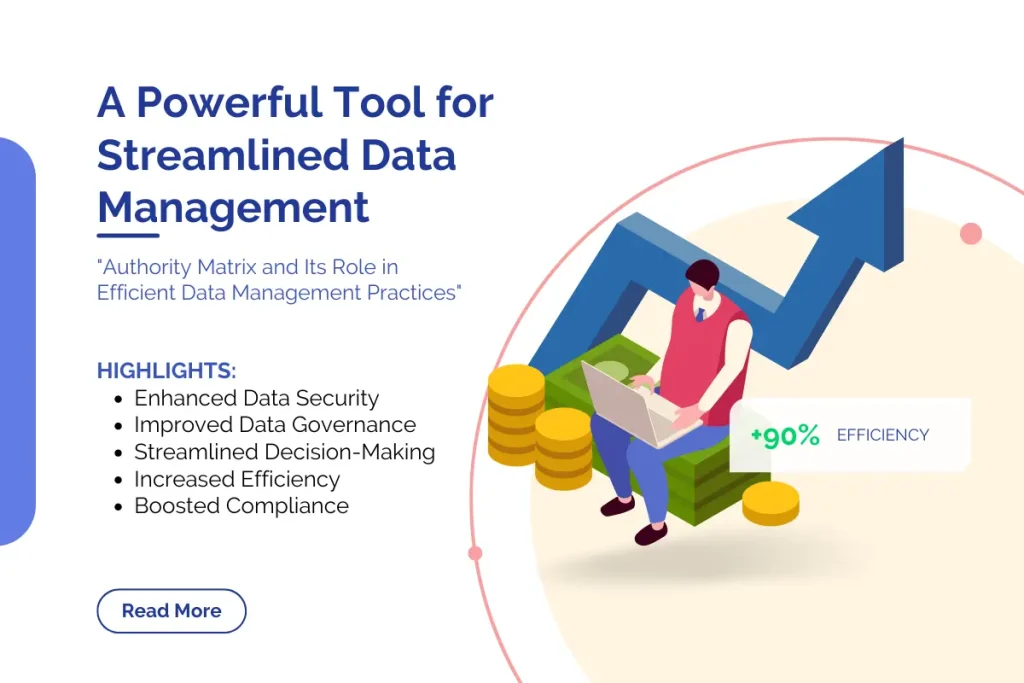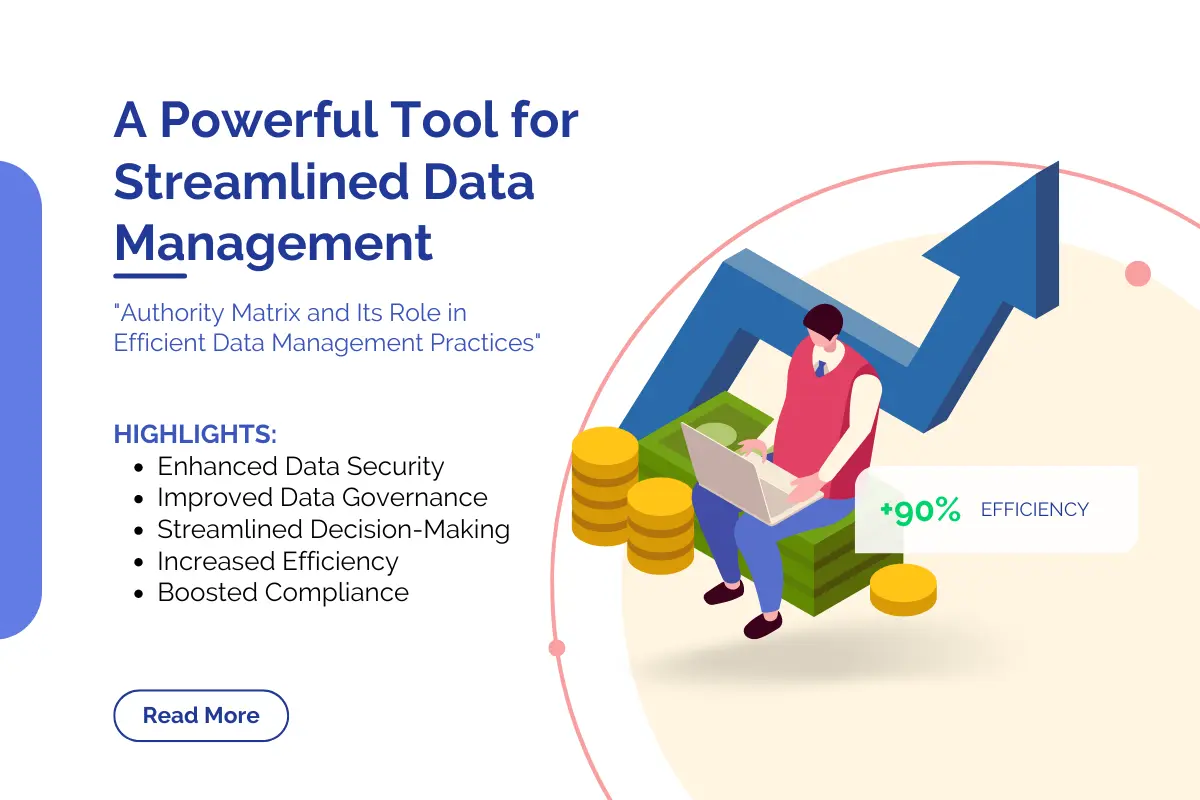Authority Matrix: A Cornerstone of Efficient Data Practices
No. | Section | Description |
|---|---|---|
1 | Introduction authority matrix efficient data | Importance of data management and introduction of authority matrix |
2 | What is an Authority Matrix? | Definition and purpose of the authority matrix |
3 | Benefits of Using an Authority Matrix | Enhanced security, improved governance, streamlined decision. |
4 | Who Should Be Included in the Authority Matrix? | Roles typically included in the matrix (data owners, stewards, users, IT security) |
5 | Creating Your Authority Matrix | Steps involved in creating an authority matrix (identifying data assets, defining access levels) |
6 | Real-World Example | Illustrative example of applying the authority matrix in an e-commerce company |
7 | Beyond the Basics: Advanced Considerations | Additional considerations for a robust authority matrix |
8 | Departmental Roles and Responsibilities | Specifying responsibilities within departments regarding data management |
9 | Data Classification | Categorizing data based on sensitivity and assigning access controls accordingly |
10 | Data Lifecycle Management | Integrating data lifecycle stages with access and disposal rights |
11 | Integration with Data Governance Tools | Leveraging software for automation and streamlining |
12 | Dynamic Data Access Controls | Implementing mechanisms for temporary access and exceptional access requests |
13 | Granular Access Controls | Exploring more granular controls within CRUD permissions and role-based access control (RBAC) |
14 | Data Ownership vs. Stewardship | Distinguishing between data ownership and data stewardship roles |
15 | Automating the Authority Matrix | Utilizing software for automating access control and user provisioning |
16 | Continuous Improvement and Monitoring | Scheduling reviews, implementing data usage logs, and leveraging user activity reports |
17 | The Evolving Landscape of Data Management | Impact of data privacy regulations and emerging technologies. |
18 | Best Practices | Recommendations for effective implementation. |
19 | Common Pitfalls to Avoid | Mistakes to be aware of (one-size-fits-all approach, lack of clarity) |
20 | Additional Resources | Links to relevant organizations (IAPP, ISO) |
#Introduction
In today’s data-driven world, organizations are swimming in a sea of information. Efficient data management
practices are crucial to ensure data accuracy, security, and accessibility for those who need it most.
Here’s
where the authority matrix emerges as a powerful tool, fostering clarity and streamlining decision-making
around
data access and control.

1. What is an Authority Matrix?
An authority matrix is a visual tool that maps out the relationships between different roles or departments
within an organization and their respective authority over specific data assets. Essentially, it defines who
can
access, create, edit, and delete (CRUD) different types of data.
2. Benefits of Using an Authority Matrix:
- Enhanced Data Security: By clearly outlining access levels, the authority matrix
minimizes
the risk of unauthorized data modification or breaches. - Improved Data Governance: It promotes accountability and ensures data ownership, making
it
easier to track data lineage and maintain data integrity. - Streamlined Decision-Making: The matrix facilitates clear communication regarding data
access requests, eliminating confusion about who has the final say. - Increased Efficiency: Well-defined data access protocols enable users to quickly locate
the
data they need and avoid wasting time on access permission hurdles. - Boosted Compliance: The authority matrix efficient data aligns with data privacy regulations like GDPR
and
CCPA by demonstrating clear data ownership and access control processes.

3. Who Should Be Included in the Authority Matrix?
The specific roles included in the matrix will vary depending on your organization’s structure and size.
However, some typical roles might include:
- Data Owners: The individuals or departments ultimately responsible for specific data
assets. - Data Stewards: The accountable parties who oversee data quality, consistency, and
compliance within their assigned area. - Data Users: Individuals or departments with a legitimate need to access specific data
for
their work. - IT Security Team: Responsible for managing user access controls and enforcing security
protocols.
4. Creating Your Authority Matrix:
- Identify Data Assets: Start by listing all the critical data sets within your
organization.
This could include customer data ,authority matrix efficient data financial records, employee information, intellectual property, and
more. - Define Access Levels: Determine the different levels of access required for each data
asset. Common access levels include:- Read-Only: View data but cannot edit or delete.
- Edit: Modify existing data entries.
- Create: Add new data entries.
- Delete: Remove data entries (with appropriate safeguards).
- Full Control: All CRUD permissions.
- Map Roles to Data Assets: Assign the appropriate access level for each role concerning
specific data sets. - Secure and Maintain: Store the authority matrix in a secure location and review it
regularly to ensure it reflects any changes in roles, data assets, or access needs. Consider utilizing
dedicated data governance software for managing and visualizing the matrix.
5. Real-World Example:
Imagine an e-commerce company. The authority matrix might show that the marketing team can access customer
names authority matrix efficient data
and purchase history for targeted campaigns (Read-Only). However, customer credit card details would be
restricted to the finance department with Full Control. This ensures data security while facilitating
efficient
data utilization in various departments.
6. Beyond the Basics: Advanced Considerations
- Departmental Roles and Responsibilities: Go beyond generic roles and clarify
responsibilities within each department regarding data management. - Data Classification: Categorize data based on sensitivity (e.g., public, confidential,
highly confidential) and assign stricter access controls for sensitive data. - Data Lifecycle Management: Incorporate data lifecycle stages (creation, storage, usage,
archival, deletion) into the matrix to define access and disposal rights at each stage. - Integration with Data Governance Tools: Leverage data governance software to automate
access control processes, track data lineage, and streamline user provisioning.
7. Dynamic Data Access Controls:
- Temporary Access Requests: Implement mechanisms for temporary access requests. For
instance, a marketing campaign might require a sales representative to access specific customer data
sets
for a limited period. The authority matrix can facilitate granting temporary Read-Only access while
maintaining overall data security. - Approval Workflows: Define clear approval workflows for exceptional access requests.
This
might involve approvals from data owners, data stewards, or IT security personnel based on the data’s
sensitivity and the requesting user’s role.
8. Granular Access Controls:
- Field-Level Restrictions: Move beyond basic CRUD permissions by considering more
granular
controls within each level. For example, a user with Edit access might be restricted to modifying
specific
data fields within a record. - Role-Based Access Control (RBAC): Explore RBAC models that define pre-configured
permission
sets for various user roles, simplifying access management.
9. Data Ownership vs. Stewardship:
- Distinguishing Roles: Clearly distinguish between data ownership and data stewardship
roles
within the matrix.- Data Owners: Have ultimate decision-making authority over their assigned data
assets. - Data Stewards: Responsible for ensuring data quality, consistency, and
compliance
within their area, acting as a liaison between data owners and users.
- Data Owners: Have ultimate decision-making authority over their assigned data
10. Automating the Authority Matrix:
- Automated Access Controls: Leverage data governance software to automate access control
processes based on the authority matrix efficient data pre-defined authority matrix efficient data. This minimizes manual effort and ensures consistent
application of access rules. - Integration with User Provisioning Systems: Integrate the authority matrix with user
provisioning systems, allowing automated access provisioning and de-provisioning based on user roles and
job
changes.
11. Continuous Improvement and Monitoring:
- Regular Reviews: Schedule regular reviews of the authority matrix to reflect any
changes in
roles, data assets, or access needs. - Data Usage Logs: Implement data usage logs and audit trails to monitor data access
patterns
and identify any potential security breaches. - User Activity Reports: Leverage user activity reports to identify potential data access
issues and ensure users are utilizing data according to their assigned permissions.
12. The Evolving Landscape of Data Management:
Data privacy regulations like GDPR (Europe’s General Data Protection Regulation) and CCPA (California
Consumer
Privacy Act) mandate data ownership transparency and user access control. An authority matrix is a valuable
tool
for demonstrating compliance with these regulations.
12.1 Emerging Technologies:
- Cloud Computing and Big Data: The rise of cloud computing and big data analytics
necessitates a data management strategy that is adaptable and scalable. Consider these emerging trends:- Cloud-based Authority Matrix Management: Utilize cloud-based data governance
solutions for centralized management and access control across cloud-based data repositories. - Machine Learning-driven Insights: Leverage machine learning algorithms to
analyze
data usage patterns and identify potential security risks or unauthorized access attempts.
- Cloud-based Authority Matrix Management: Utilize cloud-based data governance

12.2 Best Practices:
- Stakeholder Involvement: Involve key stakeholders from different departments (data
owners,
data stewards, IT security) during the development and review process of the authority matrix. This
fosters
collaboration and ensures the matrix reflects the needs of all data users. - Documentation and Training: Clearly document the authority matrix and access control
procedures. Conduct training sessions for users to ensure they understand their rights and
responsibilities
regarding data access. - User-Friendly Interface: If using data governance software, prioritize a user-friendly
interface for easy access to the authority matrix and requesting data access. - Least Privilege Principle: Implement the principle of least privilege, granting users
only
the minimum level of access needed to authority matrix efficient data perform their tasks effectively. - Regular Reviews and Updates: Schedule regular reviews of the authority matrix (at least
annually) to reflect any changes in roles, data assets, or access needs. Conduct audits to ensure the
matrix
is being followed effectively.
12.3 Common Pitfalls to Avoid:
- One-Size-Fits-All Approach: Avoid creating a generic authority matrix for the entire
organization. Tailor the matrix to cater to the specific data access needs of different departments and
data
assets. - Lack of Clarity: Ensure the authority matrix is clear, concise, and easy to understand
for
all users. Avoid using ambiguous language or complex access control structures. - Inconsistent Enforcement: Inconsistent enforcement of the authority matrix can
undermine
its effectiveness. Ensure all departments and users adhere to the defined access levels. - Neglecting User Training: Skipping user training on the authority matrix and access
control
procedures can lead to confusion and potential security risks. - Ignoring Data Classification: Failing to categorize data based on sensitivity can lead
to
overly restrictive or lax access controls.
13. Additional Resources:
For further reading and standards related to data governance and information security, consider exploring the
following resources:
- International Association of Privacy Professionals (IAPP): https://iapp.org/
- International Organization for Standardization (ISO): https://www.iso.org/ (Search for standards related to data
governance
and information security)

